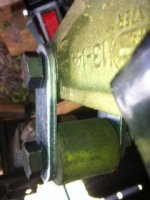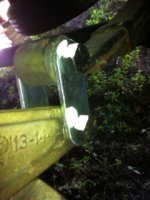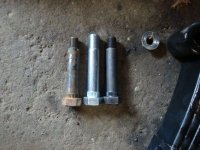Garypowell
Well-known member
The big day was supposed to be yesterday but between a late start and then realizing I did not have enough wood for the jacks to work properly the installation was today.
In general the installation went fairly easy. It took me and my nephew about 5 hours to do the installation. But I also checked the brakes and greased the bearings as they have easy lube (yes I put the grease in very slowly…and they seemed to work fine). I have a couple of question as some of it did not go as I thought.
1. No matter what we tried we could not get most of the bolts to seat all the way flush into their holes. We tried several techniques:
a. Drawing them in as we used a double wrench.
b. Beating on them with a hammer.
c. We devised a board with a hole in it (so the other end of the bolt was protected) and then used a C clamp on the heads.
But no matter what we did we could not get them fully engaged…..like the ones we took out were. In my opinion they are all about ½ engaged….and they did not rotate when I tightened them. I also used a torque wrench to put the 50 Pounds on them….and they did not rotate.
Had the most success with the new brackets supplied.
You can see the pictures below (Gap 1, 2, 3)
So the question is…..do I have something to worry about here or is this fairly normal?
2. Secondly, it was my understanding that you replaced the bushings on the Dexter E-Z Flex too. I did not. First the top bushing was a lot bigger than the never fail size….even the bolt was bigger. So no go there. I did notice there was no lubrication in sight….took care of that today and grease went in easily.
The other two had brass bushings in them….they looked fine and tight….so I left them as they were.
That’s the second question….I thought I have heard from others they have replaced these bushing…..how did you get around the bigger bolt issue?
I am going to call Mobile Outfitters early next week to see what gives with my two questions. But obviously would like to hear the opinions of the EXPERTS!
To help protect myself I put paint on the bolts so I can see if they start to spin….we’ll see how that works. Put in a picture to show.
I am very glad I did the upgrade and will be happier once I am comfortable that the new bolts supplied don’t usually go all the way in. The main reason I am glad is that one of my bushings had already failed. I have about 2,500 miles on the Rig since purchase last November.
I look forward to hearing what you all have to say.




In general the installation went fairly easy. It took me and my nephew about 5 hours to do the installation. But I also checked the brakes and greased the bearings as they have easy lube (yes I put the grease in very slowly…and they seemed to work fine). I have a couple of question as some of it did not go as I thought.
1. No matter what we tried we could not get most of the bolts to seat all the way flush into their holes. We tried several techniques:
a. Drawing them in as we used a double wrench.
b. Beating on them with a hammer.
c. We devised a board with a hole in it (so the other end of the bolt was protected) and then used a C clamp on the heads.
But no matter what we did we could not get them fully engaged…..like the ones we took out were. In my opinion they are all about ½ engaged….and they did not rotate when I tightened them. I also used a torque wrench to put the 50 Pounds on them….and they did not rotate.
Had the most success with the new brackets supplied.
You can see the pictures below (Gap 1, 2, 3)
So the question is…..do I have something to worry about here or is this fairly normal?
2. Secondly, it was my understanding that you replaced the bushings on the Dexter E-Z Flex too. I did not. First the top bushing was a lot bigger than the never fail size….even the bolt was bigger. So no go there. I did notice there was no lubrication in sight….took care of that today and grease went in easily.
The other two had brass bushings in them….they looked fine and tight….so I left them as they were.
That’s the second question….I thought I have heard from others they have replaced these bushing…..how did you get around the bigger bolt issue?
I am going to call Mobile Outfitters early next week to see what gives with my two questions. But obviously would like to hear the opinions of the EXPERTS!
To help protect myself I put paint on the bolts so I can see if they start to spin….we’ll see how that works. Put in a picture to show.
I am very glad I did the upgrade and will be happier once I am comfortable that the new bolts supplied don’t usually go all the way in. The main reason I am glad is that one of my bushings had already failed. I have about 2,500 miles on the Rig since purchase last November.
I look forward to hearing what you all have to say.





